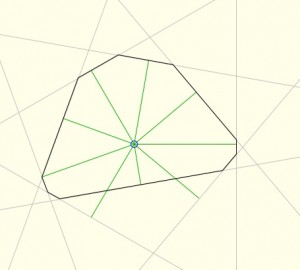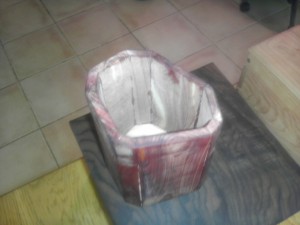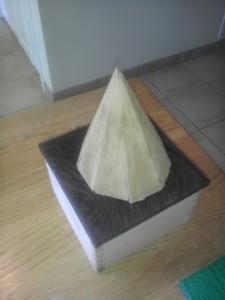Nonagons and nonsense, nonagonography, non-sequiturs, nonesuch, none of that now, not for the faint of heart… This is a long post and would that it were just about nonagons there would be the weak chance that some overall sense could be made of it. It is more the case here nonagons are just being used, exploited even, to discover what properties may adhere to irregular but equi-angluar polygons. Henceforth in this post such irregular but equi-angular polygons will be referred to as IBE polygons.
This started simply enough, a plastic cup as pencil holder on my desk taunting me that it needed to be restored to the proper destiny of plastic cups and that a suitable wooden substitute be created in it’s place. Not having a lathe I immediately began to consider options in regular polygons and quickly settled on nine as being nicely divisible into 360, being non-standard (no pun), as affording sufficient creative license.
The next question that seemed a natural follow-on was ‘Why regular?’. The answer was half-practical, so that the angles could be known and cut, but some variance, of the side lengths perhaps, as a rectangle is a stretched square, an IBE square if you will, seemed interesting. This led to thoughts about whether IBE polygons could be made with an odd number of sides (yes), a prime number of sides (yes) and what constraints describe the construction of IBE polygons. Just as a matter of assurance, completely irregular polygons were never considered.
Using the fact that 40 degrees is the central angle for a regular nonagon pie slice it stood to reason that 20 degrees would be a proper bevel to create the 70 degree wall side angle needed to create a nonagon. I cut an array of such beveled lengths to test simple ideas.
Main learning here was that IBE polygons were a subtler reality than initially perceived, that they bore an intriguing similarity to the way crystals grow in nature, and that I could describe almost nothing about the constraints that pertain to them.
I talked to a few of my general sages and did some browsing/research. I came upon several interesting things, among them Naploeon theorem – http://mathworld.wolfram.com/NapoleonsTheorem.html and the extensibility of Viviani’s theorem (http://en.wikipedia.org/wiki/Viviani’s_theorem) to IBE polygons. I came upon a nice applet that lets one deform regular polygons into IBE polygons. http://www.cut-the-knot.org/Curriculum/Geometry/EquiangularPoly.shtml. The java on this page was out of date but running it proved satisfactory. I was able here to become sure of both that there were more possibilities of irregularity than I could readily organize into intuitive classes and that yet that I am certain that some collection of line lengths are excluded. It might be that the answer of what is in the set is expressed as range of ratios for the members, but that seems unlikely – something about prime factoring is tempting but likely false – in short, cluelessness.
Many experiments were conducted
The IBE nonagon pencil holder was built
But a satisfactory answer on the question of what criteria describe, for any IBE polygon of N sides, ratio ranges of valid segments is unanswered. In the case of regular polygons we can express the area in terms of the number of sides N (assume 1 as the side length). For IBE polygons that 1 must be substituted with some sort of complex ration expression dictated by the segments.
I’ll return to this unless the committee on coherent expression and useful theories weighs in. I believe that there’s a body of knowledge out there that has terms for the majority of what I’m grappling at and has at least a portion of the insight I am seeking. If anyone has a hint please share. I’m thinking I’ll do some rough looking at whatever theories describe the growth of crystal formations. They’d have to have language that addresses some of this.
thanks,
(June 24th – update)
No theoretical progress but the blades being set did yield an almost involuntary nona-cone/wooden tepee, spire thing.
One thing too about doing anything nine-sided and getting to use the nona- prefix, is that given the conventional non- as not, a lot of possible humor arises. A nonaspire, for example, aspires not.











